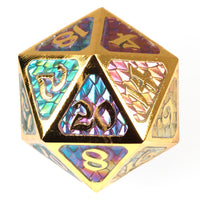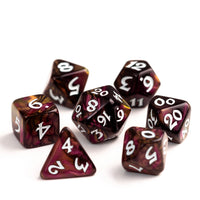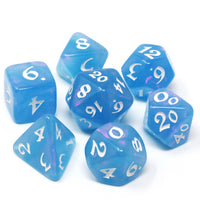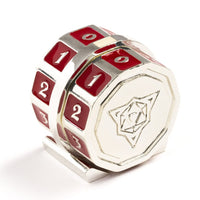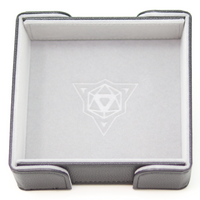Dice Tray: Enhance Your Gaming with Style
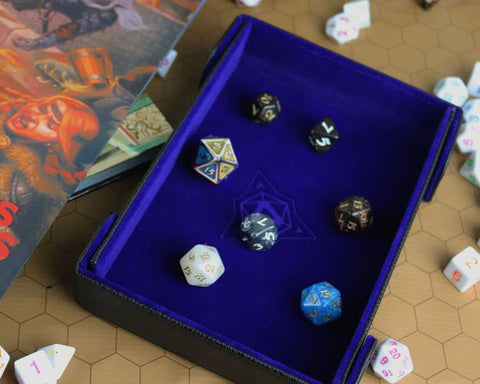
As a tabletop gaming enthusiast, you've likely encountered various types of rolling trays throughout your gaming experiences. Dice trays have evolved significantly over time, becoming an essential accessory for many players to enhance their gameplay and protect their gaming surfaces. In this blog post, we will trace the history and evolution of rolling trays from their early days in tabletop gaming to today's modern designs.
We'll describe their use in tabletop gaming and examine traditional materials used in their construction. You'll learn about the emergence of folding designs, such as Die Hard Dice's Magnetic Portable Table Armor, which offers numerous advantages over snap-based designs.
Lastly, we'll guide you through choosing the right material for your ideal dice tray by comparing wood, plastic, leather, fabric choices along with animal-friendly alternatives. By considering factors such as material quality, size dimensions, and brand reputation, you can make an informed decision on selecting the perfect dice tray to suit your specific gaming needs.
Dice Tray Topics of Interest
- Evolution of Dice Trays
- Rise of Role-Playing Games (RPGs) in the 1970s
- DIY Solutions for Gamers Seeking Portability
- Die Hard Dice's Impact on Folding Dice Trays
- Upgrading Snap-Based Design with Magnets
- Features That Make Magnetic Folding Portable Dice Trays Stand Out
- FAQs in Relation to Dice Tray
Evolution of Dice Trays
The history of the dice tray is closely tied to the growth of tabletop gaming, particularly RPGs like Dungeons & Dragons in the 1970s. Traditional trays were often made from wood or plastic and had raised edges but were bulky and difficult to transport. Eventually, folding dice trays emerged as a more portable solution, with flexible materials such as leather or fabric for the rolling surface and collapsible edges.
Rise of Role-Playing Games (RPGs) in the 1970s
As RPGs gained popularity, players looked for ways to improve their gaming experience. Trays became an essential accessory that helped keep dice contained and gaming surfaces uncluttered. In addition to providing a designated area for rolling, they also prevented dice from getting lost or accidentally knocked off tables during intense gameplay sessions.
DIY Solutions for Gamers Seeking Portability
Dice trays likely began as DIY solutions created by gamers who needed a more portable option than traditional wooden or plastic models. These early versions may have been crafted using simple materials like cloth or cardboard combined with tape or glue to hold them together when not in use. And who can forget the original classic when playing a board game: the box lid itself!
- Dice Trays: Tabletop accessories designed to provide an organized space for rolling game pieces while preventing them from being lost during play.
- Tabletop Gaming: A hobby involving various types of games played on flat surfaces, including board games, card games, miniatures wargames, tile-based games and role-playing games (RPG).
- Metal Dice: High-quality game pieces made from metal alloys instead of traditional plastic materials; popular among serious gamers for their durability and unique appearance.
- Wooden Trays: Traditional dice trays made from solid wood materials, typically lined with velvet or neoprene.
In the late 1990s and early 2000s, companies started producing folding dice trays commercially. Different manufacturers provide an array of styles, components, and sizes to meet various wants and requirements. Some popular brands include Wyrmwood Gaming, known for its high-quality wooden trays with intricate designs. In the mid-2010s Die Hard Dice popularized the portable folding form factor.
Folding dice rolling trays have come a long way since their DIY origins - they are now widely available gaming accessories that enhance the tabletop experience for many players around the world.
Dice rolling trays have evolved over time, with folding trays emerging as a more portable solution for gamers going to friends' houses or local game stores. As RPGs gained popularity in the 1970s, players looked for ways to improve their gaming experience and prevent dice from getting lost or accidentally knocked off tables during gameplay.
Die Hard Dice's Impact on Folding Dice Trays
In the mid-2010s, Die Hard Dice revolutionized the tabletop gaming accessory market by popularizing folding trays with snaps. The company introduced a unique design that combined portability and functionality, making it an instant hit among gamers.
Introduction of Snap-Based Design by Die Hard Dice
Prior to Die Hard Dice's innovation, portable and collapsible trays were not as prevalent or convenient in the tabletop gaming community. The company designed a tray using synthetic leather and plush velvet for the rolling surfaces and edges that snap together to create a secure tray for rolling dice. This innovative approach allowed players to easily transport their trays without worrying about them losing shape or taking up too much space. The original Die Hard Dice folding tray was the same size as a sheet of paper, so it could easily fit into binders and backpacks.
Growing Popularity Among Tabletop Gaming Community
The introduction of this snap-based design quickly gained traction within the tabletop gaming community due to its convenience and practicality. As more gamers started using these folding dice trays during their sessions, other companies took notice and began creating similar products based on Die Hard Dice's successful model. This led to an expansion of the folding dice tray market, enhancing gameplay experiences for many players around the world.
- Durable: Animal friendly synthetic leather provides strength while maintaining flexibility for easy transportation.
- User-friendly: Snaps allow users to quickly assemble/disassemble their trays when needed.
- Versatile: Accommodates various types of games such as Dungeons & Dragons, Pathfinder, Magic: The Gathering, etc., ensuring compatibility across multiple platforms.
The snap-based design proved to be an excellent alternative to traditional wooden or plastic trays, which can be bulky and less portable.
However, despite its initial success, Die Hard Dice discovered that snaps could sometimes cause issues such as being too strong or weak, leading them to explore other options like magnets for their upgraded "Table Armor" line. This new approach provided even better hold without sacrificing portability while maintaining the company's commitment to quality gaming gear at affordable prices.
Check out Die Hard Dice's Magnetic Folding Portable Dice Trays here.
Upgrading Snap-Based Design with Magnets
The snap-based design of folding dice trays, while innovative at the time, faced some challenges. Snaps could sometimes be too strong or weak, leading to an unstable tray setup. In other cases, snaps would break altogether and render the tray unusable. To address these issues and improve their product offering, Die Hard Dice made a significant upgrade by incorporating magnets into their popular Table Armor line.
Issues Faced with Snap-Based Designs
- Strength inconsistency: Snaps varied in strength which led to either difficulty in snapping them together or keeping them securely fastened.
- Durability concerns: The potential for snaps to break over time posed a risk for long-term usability of the dice trays.
- Limited portability: Protruding rivet snaps on traditional designs made it difficult for gamers to carry their trays in folders or backpacks without causing damage.
Benefits Offered by Magnetic Folding Dice Trays
Magnetic folding portable dice trays provide several advantages over snap-based models that enhance both functionality and user experience:
- Better hold: Magnets offer a firm connection between tray walls ensuring stability during gameplay without compromising ease of assembly or disassembly.
- Increase portability: No protruding rivet snaps mean magnetic folding dice trays are more folder-friendly than before - perfect for gamers who need a convenient way to transport their gaming accessories from one session to another.
- Improved durability: Magnets are less likely to break compared to snaps, providing a longer-lasting solution for tabletop gaming enthusiasts.
- Enhanced quality at an affordable price: Die Hard Dice is committed to offering high-quality gaming gear without breaking the bank. The introduction of magnets in their dice trays has further elevated product quality while maintaining affordability for customers.
With these benefits in mind, it's clear that magnetic folding portable dice trays from Die Hard Dice offer significant improvements over traditional snap-based designs. Gamers can now enjoy a more reliable and convenient way to roll their favorite metal dice during intense sessions of Dungeons & Dragons or other tabletop games.
Die Hard Dice has upgraded their Table Armor line of folding trays by incorporating magnets, which provide better hold and durability compared to the previous snap-based design. Magnetic portable trays are also more folder-friendly and affordable while maintaining high-quality standards for tabletop gaming enthusiasts.
Features That Make Magnetic Folding Portable Dice Trays Stand Out
The innovative magnetic folding portable dice trays from Die Hard Dice offer numerous advantages over traditional models, making them a must-have accessory for tabletop gaming enthusiasts. The key qualities that make these trays stand out from other options and make them a great pick for gamers are outlined here.
Easy Transportation and Setup
One of the main benefits of using a magnetic folding portable dice tray is its ease of transportation. The compact design allows it to fit easily into backpacks and folders, ensuring you can bring your trusty dice tray wherever your gaming adventures take you. Additionally, the durable magnets used in these trays ensure a perfect setup without any hassle or fuss associated with snaps.
Protection for Surfaces and Minis
Metal dice are known to be quite heavy and sharp-edged, which can cause damage to surfaces like tables or books when rolled directly on them. A magnetic folding portable dice tray provides a protective barrier between your metal dice and any surface they may come into contact with during gameplay. This not only prevents potential damage but also helps keep your gaming area looking pristine.
- Noise Reduction: Rolling metal or even plastic dice on hard surfaces can create quite a bit of noise - especially if playing in public spaces or late at night when others might be sleeping nearby. These magnetic folding portable trays help quiet loud rolls by providing a soft rolling surface that absorbs sound better than harder materials such as wood or plastic.
- Dice Containment: Keeping track of all those small rolling objects during intense gameplay sessions can be challenging - especially if they have a tendency to roll off the table or get lost among other game components. A dice tray helps keep your dice contained and prevents them from interfering with miniatures on the gaming table.
- High-Quality Materials: Die Hard Dice's magnetic folding portable trays are made using top-of-the-line materials, such as high-weight PU leather on one side and ultra-soft plush velvet on the other. This combination of materials not only looks fantastic but also feels great to hold and use during gameplay.
Die Hard Dice's magnetic folding portable dice trays are a must-have accessory for tabletop gaming enthusiasts due to their easy transportation and setup, protection for surfaces and minis, noise reduction, dice containment, and high-quality materials.
FAQs in Relation to Dice Tray
What is the purpose of a dice tray?
A dice tray serves multiple purposes in tabletop gaming. It provides a designated rolling area, preventing dice from scattering or falling off the table. Additionally, it protects surfaces from scratches and dents caused by heavy or sharp-edged dice while reducing noise during rolls.
What are dice trays lined with?
Trays are typically lined with materials that offer cushioning and noise reduction for rolled dice. Common lining materials include felt, velvet, neoprene rubber, foam padding, suede fabric, or other soft textiles. These linings help protect both the surface of the tray and your game pieces while ensuring quieter rolls.
How big should a dice rolling tray be?
The ideal size for a tabletop dice tray depends on personal preference and available space at your gaming table. A common size range is between 8x8 inches to 8x12 inches (20x20 to 20x30 cm). Smaller trays provide portability but may limit dice movement when rolling.
What are the dimensions of a typical folding dice tray?
Folding tabletop dice trays typically come in rectangle or square shapes or hexagonal shapes. A rectangle tray is usually the same size as a sheet of paper at 8.5x11 inches (22x28 cm) when unfolded flat. When folded into its rectangular shape for use as a rolling surface, it makes a box about 5x7 inches in size (13-18 cm).
